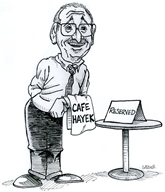The Wall Street Journal‘s Paul Gigot spoke yesterday with Phil Gramm about Gramm’s and my new book, The Triumph of Economic Freedom (which you can buy here).
My emeritus GMU Econ colleague Larry White talks with George Selgin about George’s superb new book, False Dawn: The New Deal and the Promise of Recovery, 1933–1947 (which you can buy here).
By examining alternative studies and methodological adjustments, Winship contends that the negative effects of trade with China have been significantly exaggerated and that populist narratives blaming this trade for U.S. economic decline aren’t supported by rigorous evidence.
The originators of the China shock theory examined how Chinese imports affected certain U.S. locales compared with others—not with the entire country—based on initial industry composition and employment size. By these metrics, areas heavily exposed to Chinese imports showed disproportionately worse manufacturing job losses.However, Winship points out that even if we accept these estimates, the findings suggest only relatively modest employment effects.
…..
Winship’s critical reassessment of the China shock clarifies the actual, limited role Chinese imports have played in manufacturing-employment trends. The real “shock” America faces in 2025 is not from Chinese imports but from a resurgence of misguided protectionism based on a misdiagnosed problem. The path forward harnesses trade’s real benefits rather than chasing economic illusions.
The trade court’s ruling states that the International Economic Emergency Powers Act, or IEEPA, can’t authorize sweeping tariffs without violating what is known as the nondelegation doctrine. A three-judge panel ruled that IEEPA doesn’t grant unlimited, unreviewable authority for the president to declare national emergencies unilaterally or impose tariffs arbitrarily. The ruling cited foundational Supreme Court cases such as Youngstown Sheet & Tube v. Sawyer, as well as more recent decisions such as Loper Bright Enterprises v. Raimondo, on improper delegation of authority from Congress to the executive branch. The court also invoked the “major questions doctrine” of the Roberts court as part of the argument against Mr. Trump’s claim of broad trade authority.
In its argument before the trade court, the administration heavily relied on U.S. v. Yoshida International, a 1974 Supreme Court decision that upheld President Nixon’s brief imposition of a 10% across-the-board tariff aimed at addressing a trade deficit spike. But that reliance ultimately undermines the administration’s case for three key reasons.
First, Yoshida involved presidential authority under the Trading with the Enemy Act, a statute that was later expressly amended to curtail executive power. Second, the Yoshida opinion emphasized the narrow and temporary scope of Nixon’s tariffs, which stands in contrast to Mr. Trump’s broader measures. Finally, following Nixon’s actions, Congress enacted Section 122 of the Trade Act of 1974, granting the president more narrowly defined authority to respond to trade imbalances.
Ethan Yang and Ryan Yonk explain that “China’s ‘vanishing’ data can’t hide its economic slowdown.” A slice:
The People’s Republic of China, after a series of market reforms in 1978 and ascension to the World Trade Organization (WTO) in 2001, experienced an economic miracle, going from one of the world’s poorest countries to the second largest economy. The explanations for this are myriad and well-recited. These include an emphasis on manufacturing and cheap but increasingly productive labor, strong educational achievement, stable governance, and being generally open for business, especially for a Communist regime. China, however, also indulges large-scale industrial policy, has a comparatively low degree of economic freedom, and has a political system that reacts wildly to anything that may threaten the CCP’s hold on power. The last point is especially relevant post-2012, when Xi Jinping, the current president, came to power and decided that the country had ceded too much to the alleged chaos of the private sector, prompting a drastic curtailing of political and economic liberties.
As economic growth slowed, for both natural and policy reasons, the government began releasing less and less information. China, which used to boast about double-digit annual growth rates, is now growing at a rate of roughly 3-4 percent, according to some experts. Although this would be considered strong for a developed country like the US, China’s GDP per capita is multiple times lower, and room for substantial growth remains.
David Henderson lays out Adam Smith’s case against imperialism.
GMU Econ alum Dominic Pino reports that “air travel has never been better.” A slice:
So, yes, it’s more crowded, but that’s because you can afford it. It’s nice to look at old pictures of people flying in the 1960s in less crowded planes, but those are pictures you probably would not have been in because it was so expensive to fly.
And because those are just pictures, you can’t see or hear or smell all the displeasures of flying on old airplanes. [Tony] Morley writes:
Flying through much of the 20th century, presuming you could afford the privilege, was a loud, turbulent, rattling, poorly pressurised, smoke-filled, boring saga with only a magazine or book for entertainment. . . . Modern aircraft fly higher, smoother, and have improved cabin pressure, air conditioning and noise insulation, dramatically reducing fatigue and pressure-related discomfort, have improved radar and navigation systems to better avoid turbulence, and are frequently equipped with entertainment systems, high-speed satellite Wi-Fi and flight tracking, unimaginable to those flying in the primitive days of the eighties, nineties and early 2000s.
One of the few areas that has not improved in the past few decades is the speed at which planes fly. A few companies are in the process of getting regulations overturned to allow for more supersonic flight, but until then, airlines have been able to greatly improve turnaround times for aircraft, which has the effect of increasing capacity by allowing more frequent flights. Morley also lists more direct flights, faster refueling, and automated scheduling systems as improvements that have reduced frictions in the overall air travel experience.



